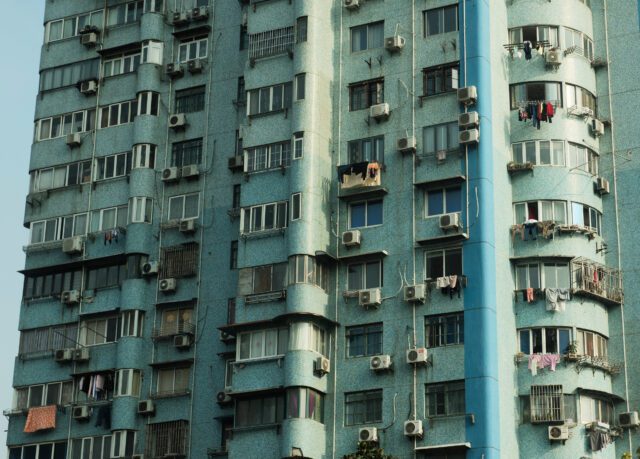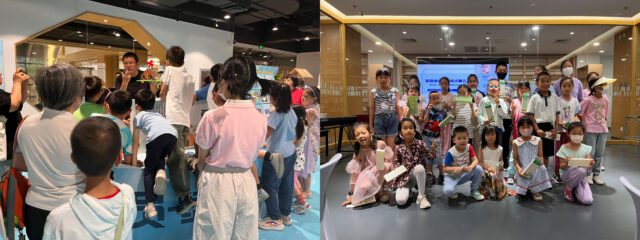-
Cool Communities: Raising Awareness about Green Cooling in China
Li Meini, a junior high school student in Beijing’s Tiantongyuan Community, was seeing more news about wildfires, floods and heat waves and couldn’t stop worrying about the safety of the local wildlife. “…Animals have nowhere to escape from wildfires and floods…their homes are destroyed in an instant. Humans have technology to reduce the impact of climate warming. I hope these technologies can also help wild animals better survive.”
So Li Meini decided to act. With the support of her teacher, she signed up for a science and technology competition based on the theme of green cooling held by the Institute for Global Decarbonization Progress (iGDP), a Beijing-based climate think tank.
With a team of other students, she created a model for a Future City that incorporates solar power components for zero-carbon cooling and an energy-efficient sensor network to provide timely extreme heat warnings for residents. Their model was exhibited at a community fair in Beijing’s Tiantongyuan, which with a population of 700,000 people is the largest community in Asia.
Li Meini and her Future City Model
The Climate Cost of Keeping Cool
As the world firewalks through another summer of record-breaking heat, everyone will be cranking up the AC, perhaps missing the irony that cooling technology is a growing contributor to anthropogenic greenhouse gas emissions.
Cooling has become a sine qua non in human development, undergirding advances in human health, manufacturing, transportation, food security and data storage. But keeping cool comes at a climate cost. Surging demand for cooling and refrigeration in developing countries is driving up energy use and its associated greenhouse gas emissions. According to the Global Cooling Watch report released by the UNEP at last year’s COP28, emissions from cooling will increase to 4.4 – 6.1 billion tons of carbon dioxide equivalent (CO2eq) in 2050, accounting for more than 10% of that year’s projected global emissions.
COP28 also saw the launch of the Global Cooling Pledge, which aims to make cooling more affordable while curbing its GHG emissions. The philanthropic community is supporting the effort as well.
China has promoted the development of green and low-carbon cooling through a series of top-down policies such as the Action Plan for Green and High-Efficiency Cooling and the List of Recommended Alternatives to Ozone Depleting Substances. In recent years, China has also issued ambitious energy-efficiency standards for room air conditioners. But the country’s leaders have also come to recognize the importance of bottom-up actions.
Last August, at the National Ecological Environmental Protection Conference held in Beijing, President Xi Jinping called for China to “stimulate… the whole society to jointly protect the ecological environment.”
This comes on the heels of other policies encouraging public participation in China’s decarbonization. In January 2022, China’s NDRC and other six ministries issued the Implementation Plan on Promoting Green Consumption, which encourages consumers to purchase energy-saving appliances, environmentally friendly home products, and reduce unnecessary energy consumption.
But what does all that mean for China’s public? A 2018 iGDP survey of Chinese public opinion on low-carbon cities found that while 83% of respondents say they “know about” the concept of going low-carbon, only 29% said they understand the concept “very well.”
The Rubber Meets the Road
Here at iGDP, we are working to promote public engagement on low-carbon lifestyles and green cooling in China’s local communities. In collaboration with Energy Foundation China, we are developing tools and manuals for community residents on green refrigeration, helping to build public cooling spots, carrying out capacity building activities for grassroots organizations and local governments, and organizing science fairs for young people.
In Beijing’s Tiantongyuan community, iGDP provided capacity building for community leaders to plan and implement climate action projects. Community leaders first participated in knowledge-building workshops on climate change and green cooling. They then designed activities to raise awareness of low-carbon development and encourage young people to participate in community governance.
At the keystone green cooling science and innovation competition, more than 1000 young people from the community participated in the interactive event, which integrated climate change, green cooling and low-carbon lifestyles.
Although the technical aspects and dry policymaking around green cooling can be hard to follow, the science fair helped the young participants realize their vital role in China’s low-carbon transition.
We also discovered it is useful to link green cooling concepts to local priorities. Green cooling offers a solution to the long-standing local challenge of urban heat islands in Tiantongyuan. One of our events showed how community spaces can be transformed into public cooling spots, and how improving the airtightness of housing, increasing external shading facilities, and enlarging white wall areas to reduce the heat absorption can help residents stay cool and reduce energy consumption.
iGDP also organized a Climate Leadership Program, where community members worked as volunteers to develop care programs for vulnerable groups – the elderly, low-income families, and outdoor workers. Many elderly and low-income people do not turn on air conditioners to save money, which can lead to heat stroke. Groups working outdoors find it difficult to insulate themselves from high temperatures. Through the Climate Leadership Program, participants were able to gain a deeper understanding of the social equity imbalances behind global warming.
Brave New World
Recent research suggests that raising awareness is not enough. People are more likely to change when they are pressured to conform to new social norms as opposed to simply acquiring new information. This raises a chicken and egg question – does behavioral change establish new social norms or do new social norms lead to behavioral change?
Research by the Environmental Defense Fund and the MEE-affiliated Policy Research Center for Environment and Economy shows that green consumption is a “key area for targets and measures” under China’s dual-carbon policy framework. This policy language is already trickling down to China’s local levels. Beijing’s Haidian District calls for guiding the public to actively practice green and low-carbon actions in its Implementation Plan for Carbon Peaking, released in May. China has also been experimenting widely with “carbon inclusion” programs that reward individuals, communities, and small enterprises for engaging carbon-reducing behaviors.
The world must break the vicious cycle of indoor cooling and global heating. As Li Meini observed, “As hot weather becomes more frequent, we will use more energy to run air conditioners and carbon emissions will increase.” Everyone has a role to play in keeping cool without burning out the planet.
Students learning about green cooling
Chen Simin is Communications and Events Manager at the Institute for Global Decarbonization Progress
Diego Montero is Senior Program Director for Strategy and Partnerships at the Institute for Global Decarbonization Progress
Lead Photo Credit: Shanghai, China-December 2017. An apartment in Shanghai, China. Photo courtesy of Norjipin Saidi / Shutterstock.com
All Other Photo Credits: Photo courtesy of Chen Simin and Diego Montero
Sources: Beijing Haidian District People’s Government, Clean Cooling Collaborative, COP28, Energy Foundation China, Environmental Defense Fund, Global Times, Institute for Global Decarbonization Progress, Institute for Governance & Sustainable Development, NRDC, Policy Research Center for Environment and Economy, Scientific American, UN Environment Programme, Xinhua
 A Publication of the Stimson Center.
A Publication of the Stimson Center.






